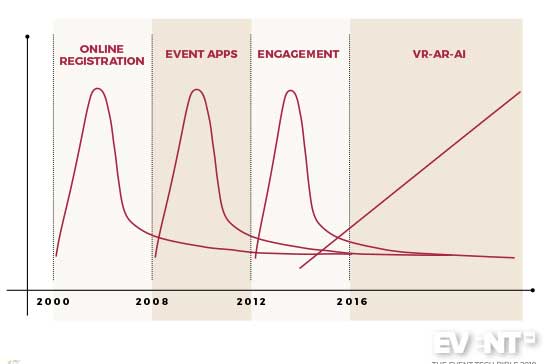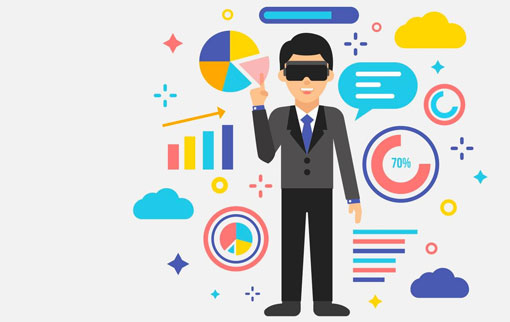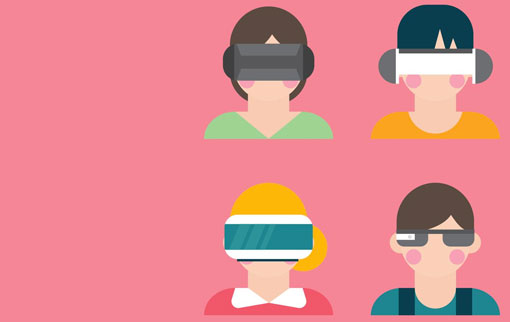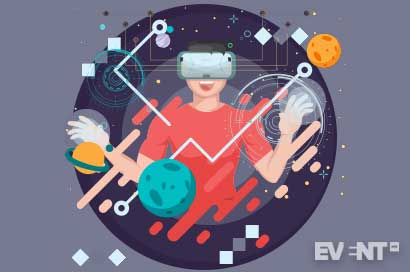I get asked very often about what’s next in event technology.
The past three waves of eventtech trends have saturated the market with somewhat satisfying adoption. Event registration, event apps and engagement tools are now “household” tech when it comes to events.

Extended Reality Is the New Playing Field for Disruption
The opportunities are incredible and geared at creating immersive experiences, the objective of many event professionals these days.
But let’s start with a definition of extended reality:
Extended reality (‘XR) is a term referring to all real-and-virtual combined environments and human-machine interactions generated by computer technology and wearables. It includes representative forms such as augmented reality (AR), augmented virtuality (AV) and virtual reality (VR) and the areas interpolated among them. The levels of virtuality range from partially sensory inputs to immersive virtuality also called VR. – Wikipedia
As a practical application for the rest of us, it’s the combination of virtual reality (think: putting on a visor and touching things in a virtual world) and augmented reality (think: pointing your phone at something that becomes animated) that creates a truly immersive experience.
A trend from 2017 that proved strong in 2018—so why does it matter now?
Extended reality may emerge as a more plausible trend over the next year in our industry, one that has the potential to completely change the array of event technology tools available on the market.
I encourage you to read this report from Accenture that sums up why mixing AR and VR works.
The benefits can be summarized as follows:
- Reduces distances to people, information, and experiences
- Safer activations
- Experience-driven
The latter, experience-driving aspect of extended reality is what really matters to event professionals, and the applications are starting to pop up all over the planet.
-
The reason why extended reality is more relevant today than two years ago is because of the advancements in the technology. We are starting to see visor-free applications that make XR more accessible and less awkward.
No more phones or bulky visors.
Events need technology that can be used fast and without glitches.
Many of us have been to trade shows and witnessed multiple VR-driven activations with lines of attendees waiting to take their turn or bulky visors that weaken the overall experience.
The same thrill-diminishing sensation arises when forced to pull out a smartphone, download an app and point it at areas of the event to get AR working. It’s too much work for busy attendees.
We need faster applications that work without too much hardware involved to achieve a surprise, experience-driven effect.
5 Extended Reality Examples at Events

Here are some practical applications that will probably give you a better idea of the possibilities:
THE AR WALL
This could quite possibly be the most captivating thing to witness at an event:
From making venues come to life with a simple screen to animated activations and promotional activities in trade show booths…
…all of the above phone-free. This is truly revolutionary for events. It may not come inexpensively now, but that may change very soon as accessibility increases.
FX MIRROR
I am incredibly excited about the FX Mirror. Currently, it is used for retail (as beacons and RFID were before entering our industry) but I can clearly see the application for experiential marketing and trade shows.
See it in action:
Imagine overlaying creative filters a la Instagram and sharing it online. This could be incredibly easy and powerful.
RIOT’S K/DA LAUNCH
OK, this is mindblowing. We have talked numerous times about extending in-person experiences for online attendees.
This is especially true for esports, which is seen by many as a future revenue stream for event professionals.
Enter Riot Games’ launch of the K-pop band K/DA.
Follow me here…
You see live performers on stage if you are attending in person at the stadium. No big news there.
But, with this AR technology, if you are watching the screens at the venue or online you can see the singers in their video game alter egos performing on stage along with their human counterparts.
See it in action:
If you were at the stadium you could not see the AR overlay unless you looked at the screen.
The event industry has played a lot with the concept of holograms and it seems we are quickly getting there. I believe we are getting to the Nokia 3210 stage of smartphone development. An iPhone is on the horizon.
LIGHTFORM
I am not sure why no media in the event industry has covered Lightform as this is probably one of the most revolutionary pieces of hardware for our industry. (Oh wait, I know why…because we are usually the first covering these types of tools.)
Lightform is projection-mapping-meets-AR. It’s very similar to what ARwall is doing in terms of the result but with a hardware-first approach.
Once again, I can see many applications, not only for reviving dull venues but also for audience engagement. Think: live recording at events in the form of an illustrator recording all discussions on a visually captivating board. How cool would it be to see discussions come to life?
Take a look:
INTERACTIVE LIGHT
Argo Design has been at the forefront of the interactive light concept since 2014 and brought the first example of environmental interaction to the Austin Maker Faire in 2016. It’s been almost three years since we started to see the beginning of what they call “interactive light.”
Imagine your attendees playing air hockey with nothing more than a table and a projector. Pretty powerful.
The Next Playground for Eventtech

We have been vocal about the lack of groundbreaking innovation in eventtech for a while. Eventtech seems to be very process-focused, which is great, and boy, do events need more of that.
But what we are missing out on is the experience factor that has been so prominent in all event trends reports since last year, including ours.
Especially if you consider the element of transformation that experiences must deliver in 2019, event technology often comes up short.
Event technology can provide an incredible “wow” factor, surprise, immersion…all elements that 2019 events crave.
I am calling on founders, developers and tech enthusiasts to incorporate more extended reality into events. I anticipate very strong XR adoption and new household categories of technology that will quickly become the standard, much like today’s use of slide projectors.
IN CONCLUSION

Extended reality is quickly becoming one of the strongest event technology trends to watch. The applications of XR for experiences are very strong.
The latest advancements in VR and AR eliminate the need for participants to wear bulky hardware or pull up their smartphone to experience the activation. The speed and immediate impact on audiences makes XR very hot for events, where time is limited.
We can expect more event technology startups to enter the ecosystem, delivering tools that not only ease the event planning process, but expanding the possibilities for event producers to inspire and engage audiences both in person or those watching the stream online.
Exciting times ahead.





